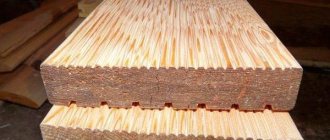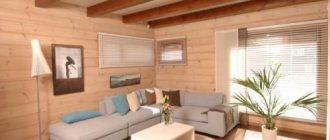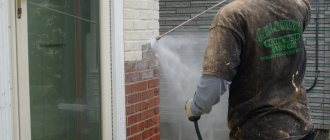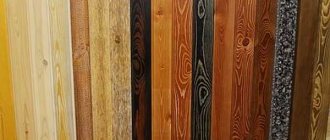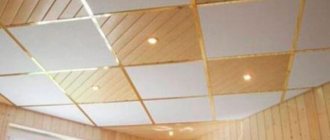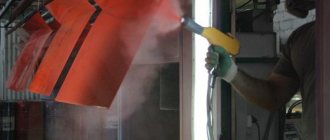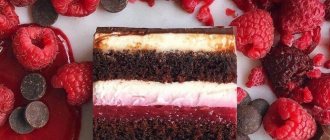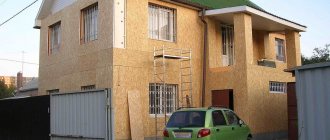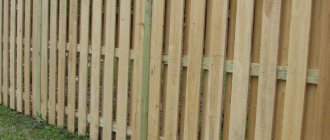Main destructive factors
Exposed wooden structures are close to nature. The structure of the tree can easily pass any liquid. It is precisely because of the accumulation of moisture in this material that various harmful microorganisms begin to develop. As a result, the product begins to collapse. Throughout the year, the boards either heat up or cool down, so they become deformed.
In this case, not every coating will be able to protect the building material. Natural wood is considered very nutritious for many fungi. They attack building materials with a lot of moisture, destroying all the fibers from the inside.
Attention! There are fungi that can destroy the entire structure in a short period of time.
Ultraviolet radiation emanating from the sun has a negative effect on wooden surfaces. It can also ruin the painting, making the veranda faded. Wood is also loved by dangerous insects. Bark beetles gnaw through many different tunnels, and over time they eat products made from this material. In addition, the tree is attacked by mice and rats, which often live in summer cottages.
Properties that paint should have
Paint for decking boards must have the following properties:
- Frost resistance. Paints and varnishes must withstand extreme temperature changes, including extreme cold.
- Moisture resistance . This term refers to the ability of paint to reject moisture from its surface after it dries. If the paint does not have hydrophobic properties, then even the slightest precipitation will lead to moisture penetration into the pores of the wood and its deformation. Moisture resistance can be enhanced by special impregnation for the terrace.
- Resistance to burnout. We are not talking about exposure to open fire, but about staying under prolonged solar radiation. Poor quality paint fades in the sun, that is, it loses its color and properties.
Important! When purchasing paint for a terrace, it is necessary to take into account the fact that for terrace paint all the properties that are listed must be significantly higher than for paint for treating the interior surfaces of a room. Since the terrace experiences much stronger environmental influences.
Types of materials for covering the veranda
So, how to paint the floor on an open veranda at the dacha so that it is reliably protected? The best option is paint. However, when choosing this material, you need to pay attention to the fact that you will have to buy a special coloring agent for the floor.
To paint the remaining elements of the structure, you can use any paint created for exterior woodwork. Coniferous wood is often used in the construction of verandas due to its reasonable cost and natural protection from water.
Also, terrace oil is sometimes used for coating, which can be classified as a protective impregnation. This material has the following important advantages:
- does not allow moisture to pass through and allows the tree to “breathe”;
- does not become cracked when deformed;
- It is necessary to treat a wooden floor with oil once every two years, but this does not require sanding or cleaning the surface. You just need to rub a new portion of the product into the floor.
Oil consumption per unit area is small: in order to cover the veranda at the dacha, 1-1.5 liters will be enough. It is recommended to tint this material before use so that the wood receives maximum protection from ultraviolet radiation. Terrace oil is one of the most popular and environmentally friendly options for treating wooden surfaces.
Yacht varnishes are what you need to cover the terrace with first of all. In terms of its composition, this product belongs to alkyd-urethane coatings and is used for processing wood products. Pros of this varnish:
- Water- and dirt-repellent properties that help save a wooden veranda.
- Excellent penetration into wood pores and small cracks. Thanks to these properties, the product completely preserves the tree, limiting its access to moist air.
- Ultraviolet resistance, which helps to preserve the beautiful color and appearance of wood for a long time.
- Yacht varnish is considered transparent and brings out the natural beauty of wooden structures.
Choosing material for the veranda
The best option for covering a wooden veranda is paint. However, when choosing this material, you need to pay attention to the fact that you should buy a special paint composition for the floor. To paint the remaining parts of the structure, you can use any paint intended for exterior woodwork.
Coniferous wood is often used in the construction of verandas. They are the most affordable material among tree species. In addition, they have natural protection from water - these are the resins with which the wood is impregnated.
For a coniferous decking board, you will need a significantly smaller amount of paint to cover it.
Acrylic latex paint
This coating has recently become increasingly popular among consumers. It has good reviews about its performance properties. In addition, the paint is easy to work with: it has no odor and is not harmful to health. Manufacturers produce this composition in a huge range of colors and shades.
Scuba diving
Aqualaki today are also popular among summer residents. They are excellent for processing decking boards.
Oil-waxes
This coating is used when they want to preserve the beautiful texture of the wood. However, this composition has one drawback - it is expensive.
I would like to note that all of the above compositions refer to expensive types of coating for wooden surfaces. But their advantage is that they look very beautiful, and they also have the longest service life.
Now we can talk about the floor covering on the terrace. This is a separate issue and quite vulnerable. This building at the dacha bears a heavy load due to the constant influence of unfavorable factors from the outside. And for the floor, such a load increases significantly, so people walk on it in shoes that are often in the swamp, and also the water on the floor does not dry out for a long time, etc.
Color selection
After choosing a covering, you need to decide what color to paint the veranda. After all, the overall appearance of the room depends on this. The most popular colors:
Brown-beige palette. Beige is very often used in decoration. This is all thanks to its advantages: a wide palette of shades, combined with different cold and warm tones, can be used as the main color and as an additional background for more saturated colors, for example, brown.
The combination of brown and beige creates a pleasant, relaxing atmosphere on the veranda. What styles should you use this palette for? These are chalet style houses in the mountains of Switzerland. Use wood and stone for decoration. Solid wood furniture with a rough texture with pillows and a blanket, a couple of stone lighting fixtures on the wall are what you need. For decoration, you can use fur skins or hunting trophies, if available.
And country is a universal type of style for a country cottage. To cover a veranda in a style called country, you need to use varnish to emphasize the texture. Install simple furniture - benches, stools, a huge table. Complement all this with textiles with a simple pattern: checkered or floral print.
Brown-green combination. Natural wood shades, complemented by green accents, look good indoors in a country house, indicate unity with nature and create a calm atmosphere. Ideal for eco-style. Complete the veranda with various plants in vases or wall panels. Furniture products should be large; you can put tree stumps instead of chairs, and make a table yourself from sawn wood.
White and blue palette. White as a base helps to expand the space in the room visually, adds airiness, and bright blue or azure brings the necessary dynamics and reminds the owners of the veranda of sea waves.
White and gray palette. Gray color is as beautiful as beige; summer residents often use it as a base. On a gray background, other color solutions look cleaner, and thanks to the large number of shades, you can create an unusual monochrome interior. Together with white, this color looks a little restrained and can be used for a Nordic style, for example, Scandinavian. This functional and strict style direction can be said to be simply created for practical citizens. Compact furniture, light and cool shades in the decoration - the Nordic character is best highlighted by the glazed building on the north side of the cottage.
How to paint a terrace so you don’t have to renew it every year
Bagretsov Alexey Vladimirovich project manager Moscow
Hello, today we will tell you about how to paint your terrace so that it lasts for a long time without re-painting.
So, first of all, let’s talk about how we painted the floor on the terrace and what we encountered during the operation of the coating...
What will you learn about in the article?
- Pros and cons of natural oil
- Pros and cons of hybrid oil
- Only the advantages of Renner YS M300 and YS A300 hydraulic oils
- Video on how to apply hydraulic oil
- Video about what kind of terraces we make and paint
Pros and cons of natural oil
At the very beginning of our work, we chose natural linseed oil Remmers PFLEGE-OL
.
This oil is available in the line of all well-known brands, Osmo
,
Tikkurila
,
Biofa
, etc.
It’s easy to work with, you apply it with a brush, remove the excess, the advantage of Remmers
is that the base is not water, but a solvent, the product does not raise the pile, and intermediate sanding is not needed.
Again, the naturalness of the product is attractive. The certificate “Suitable for children’s toys” is quite famous and inspires respect. But this product, no, any natural linseed oil has one drawback, the manufacturers do not hide it, they always write in the notation that the update must be done once a year, every spring.
Photo 1. Natural linseed oil PFLEGE-OL
So, painting an open terrace with linseed oil and forgetting it won’t work. You will have to renew the coating, otherwise there will be no effect, visually, by the way, either, since the coloring pigment lies on the surface and is washed away by melting snow.
And there is a second one: any natural oil takes a long time to dry. This means that a rising wind with dust can quite ruin both work and mood.
This disadvantage is more than offset by the low price of natural terrace oil. BUT! If the terrace is closed, then oil painting will be relevant...
Photo 2. Natural oil for terraces
None, BUT, our customers are not satisfied, and we began to test new products in order to paint the terrace at their dacha for a longer period.
Pros and cons of hybrid oil
Now let's look at the Universal OL
, which is a modification of the oil.
The manufacturer, the German company Remmers,
claims that their modification lasts three times longer than any classic product. Is it so?
Photo 3. UNIVERSAL oil - OL
During operation, the following advantages were identified:
- Universal OL
is as easy to apply as regular oil; excess is wiped off with a rag, no streaks remain, i.e. This is a great product to work with; - contains much more antiseptics, so it can be used to treat pine boards, for example, to paint a pine terrace under a canopy;
- really stands for a long time on terraces and verandas protected from precipitation.
Identified disadvantages:
- the product, which is essentially a thin-layer film glaze, begins to peel off after wet snow has been lying on it or rain has been soaking it for a long time, and requires re-sanding when re-painted. Those. Universal OL
IS NOT SUITABLE for painting outdoor terraces; - tinting according to the RAL system. Glaze composition according to RAL? Yes, this is unrealistic!!! You will never miss the color, as the wood will set its own tone;
- costs no more than one year when used outdoors.
The conclusion we made: this product can be used (it is very economical in consumption and not high in price) only when painting closed terraces and verandas. Under no circumstances should it be used where rain or snow falls on the surface.
Photo 4. Terrace oil from Remmers
Having studied this and some similar products from well-known brands, do you think we have settled on a more or less suitable classic flaxseed oil, which still serves better than the modified product? Of course not, otherwise we wouldn’t be that very “Lumber Exchange”
, which is known and appreciated by owners of suburban real estate.
We went further and found something that is used to paint terraces SO that their service life exceeds all expectations.
We were not satisfied with the result of either the first or the second option described above. In the case of natural oil, we are ready to give a solid C, and in the case of a modified product, three with a big minus, and we were not satisfied with this result, since the responsibility for painting and selling the paint, regardless of which manufacturer made it, lies with us.
Only the advantages of Renner YS M300 and YS A300 hydraulic oils
YS M300 hydraulic oil
and
YS A300.
Photo 5. Renner YS M300 hydraulic oil
The manufacturer stated that its product was created specifically for the most aggressive conditions: painting piers, walkways and open terraces. Test reports were attached, which confirmed that the hydraulic oil had a service life of 3 years on a horizontal surface, and a 15-year service life on a vertical surface.
Advantages identified during operation:
- YS M300
is very easy to apply: brush, rag, spray. Does not leave streaks. Even a non-professional can paint; - the pigment does not wash out even in dark colors (there is an example where a terrace painted with hydro-oil has been like new for 2 years, you can see the photo on the screen).
Six months after painting this terrace in KP Kronberg, our staff photographer Irina, in the fall, went to take photographs of the object. The terrace lay under wet snow and when it was swept away, the snow was not colored.
Photo 6. Terrace painted with Renner YS M300 oil
This may be trivial, but try doing this with any other brown product...
- hydro-oil contains antiseptics and fungicides, which protects wood from blue staining;
- The photos you see on the screen are of a terrace we painted, which has been standing outdoors for three years now. Three years is the minimum period for how long the coating will last before updating, which is very simple to do, just apply one layer of coating.
Video on how to apply hydraulic oil
This example is not the only one of its kind. Many customers have already used ours. We continue to maintain all objects and know the hydraulic oil YS M300
at the moment there are no analogues.
Photo 7. Terrace under Renner oil after two years of operation
Video about what kind of terraces we make and paint
If you are interested in the product, you can familiarize yourself with it by clicking on the link below. We hope that our experience will help you avoid mistakes. Have a good mood. Visit our website, read articles on our blog and stay up to date.
See how we can
April 13, 2020 1138
Wooden terrace with decorative railings
33 m2 165 000
7 days CP Kievan Rus
October 30, 2019 1261
How we made a vintage terrace in the very creative village village
39 m2 300 000
21 days CP Village
September 28, 2019 2328
How we made a cool terrace from low-grade deck boards
10 m2 79 000
9 days checkpoint Vankovo
November 27, 2018 1546
Wooden house with a larch terrace in Alexandrov Ponds
15 m2 90 000
14 days CP "Alexandrov's Ponds"
View other works
Preparation for processing
In order for the coating to lay evenly and look beautiful, you first need to prepare the surface. To do this you will have to perform several steps:
- Processing wood with a plane - removing the darkened part of the floor.
- Grinding is carried out using a small abrasive (“sandpaper”).
- Washing the floor until it shines and then drying it.
- Impregnation with an antiseptic using a brush and drying.
- Priming in three layers using special compounds.
After preparation has been completed, you can proceed to applying the material. Do not forget to dry the layers completely, otherwise the result will be unstable, and the coloring agent will have to be washed off and then reapplied.
Preparatory work for painting the floor on the veranda
Before you start painting the floors, you must take the following steps:
- The surface is thoroughly cleaned. First, large particles of debris are blown off using a compressor, then the surface is swept and finally washed with a rag.
- If the surface is moistened, it is dried with a hairdryer.
- The surface of the board is sanded if there are burrs, chips or chips.
- If there are gaps between the boards, they are rubbed with a mixture of wood sawdust and PVA glue.
- A primer coat of paint is applied, which dries within 7-8 hours (drying time varies depending on the paint).
- The base coat of paint is applied.
Important! Access to the painted surface should be limited to avoid damage. In order to prevent rotting, the surface can be additionally treated with an antiseptic.
Required Tools
To work with the coating, you need to prepare the following tools
- Planer, sandpaper or sander.
- Antiseptic.
- Primer mixture.
- Coloring agent and impregnation.
- Small and large brushes.
- Roller.
Buy everything from this list, without these tools it will be difficult to get the job done.
Painting technology
Painting is carried out in accordance with the instructions for the selected coating. Since wood has a pronounced texture, it is necessary to apply the product with a brush. The first coat must be left for 24 hours to dry. Then you can repeat the coloring to obtain a more saturated color scheme.
It is necessary to observe safety technology when working with paintwork materials, or rather, wear protective equipment. The coating can last a maximum of 5 years. Then you only need to tint with the main product, without repeating all the stages of work. Then the floor will look great again and the wood will be saved.
Coloring
Painting is carried out in accordance with the instructions for the selected coating. Since wood has a pronounced texture, it is recommended to apply the coating with a brush. The first layer must dry for at least 24 hours. Then you can repeat the painting to achieve a more pronounced color.
It is necessary to observe safety precautions when working with paints and varnishes! For protection you will need a respirator, goggles, gloves and outerwear.
The service life of the coating ranges from 2 to 5 years. Then you just need to tint with the main product, without repeating all the application steps. Then the floor will again be pleasing to the eye, and the wood will be under reliable protection.
Features of operating a terrace or open veranda
The operation of a wooden floor on an open veranda differs in many ways from closed buildings. The thing is that structures located on the street are exposed to environmental influences. What can you do to extend the life of a wooden floor in an open building? The tree must be protected, or rather covered with special means, which were discussed above.
It is difficult to say how to paint a wooden floor on an open veranda at the dacha; a lot depends on the type of construction and type of wood. However, if you pay attention to the properties of the materials, it will be easier for you to make a choice.
How to paint the floor on an open veranda at the dacha
The operating conditions for paints and varnishes on an open veranda are difficult. The paint layer is subjected to almost all possible loads:
- Temperature changes.
- Exposure to atmospheric moisture, precipitation.
- Direct sunlight.
- Mechanical loads from the movement of people.
In addition, the material being painted must be taken into account. The most commonly used floorboards are made of softwood. They are inexpensive and easy to install, but have a certain inherent moisture content that negatively affects the paint layer. In addition, conifers contain a large amount of resin that can soften or dissolve some types of paints. A larch floor may contain a large number of resin pockets, which, when exposed to the scorching rays of the sun, can flow and soak through the paint layer. These points should be taken into account when choosing a material for painting the floor. Ordinary floor paint will not work here; materials that are more resistant to external influences with high vapor permeability are needed so that the coating layer does not bubble in the sun. For such harsh conditions, several layers of protective coating will be required:
- It is necessary to saturate the floor board with an antiseptic composition. It will eliminate the possibility of mold and mildew and eliminate the prerequisites for the onset of rotting. This procedure is best done before laying the floor, so that you can saturate the boards on the back side. Impregnation is applied in 2 or 3 layers, more accurate consumption is indicated on the packaging.
- After the antiseptic, you can use a special floor oil (also called terrace oil). It is designed specifically for wood and has the ability to penetrate quite deeply into the pores, compacting and sealing the top layer.
- The layer of oil must be fixed, for which you need to use a transparent or tinted varnish. A specialized varnish for outdoor use, some types of yacht varnishes, are suitable for this.
- If you plan to use paint, the best choice is ACE acrylic enamel or alkyd enamel designed for painting piers by Parker Paint. A good solution would be latex semi-matte enamel, which does not become slippery even when wetted with water.
The list of materials that can be used on open verandas can be continued for a long time; manufacturers do not waste time and are constantly supplementing it with new types of paint that are more durable and resistant to stress.
